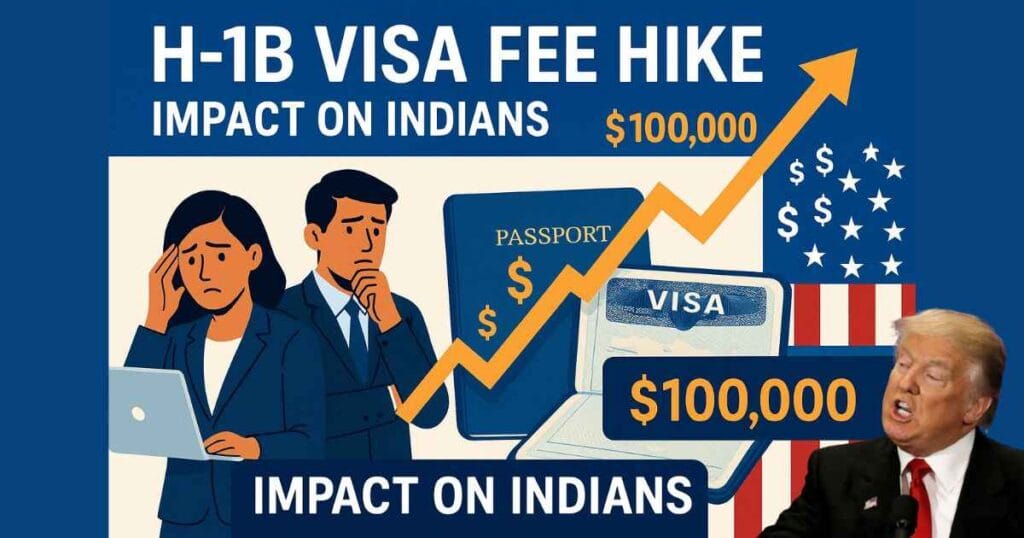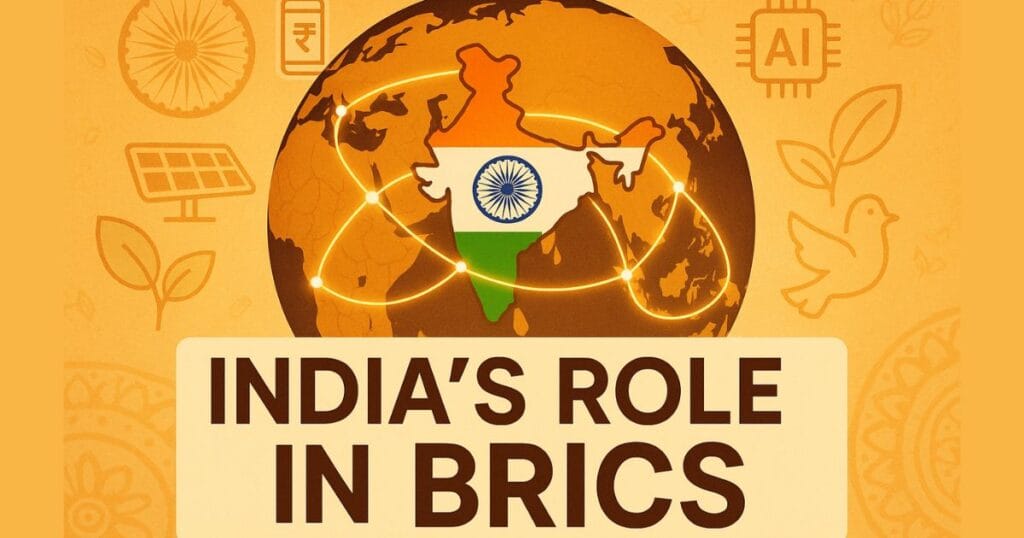The H-1B visa has been the biggest gateway for Indian professionals to secure jobs in the United States. Especially for those working in fields like IT, software development, engineering, and medicine, this visa is like turning a dream into reality. However, the U.S. government has recently increased the H-1B visa fee from $2,000-$5,000 to $100,000 (approximately ₹88 lakh). This change came into effect on September 21, 2025, and is impacting Indian professionals, students, IT companies, and India-U.S. relations. In this article, we will explain in simple language what this change is, how it will affect Indians, and what the future holds.

What is the H-1B Visa and Why is it Important for Indians?
The H-1B visa is a work permit that allows U.S. companies to hire foreign professionals. It is meant for those who have a bachelor’s degree or higher qualification and expertise in a specific field. This visa is particularly important for Indians because:
- Demand for Indian Talent: In 2023, 72% of those who received the H-1B visa were Indians, especially software engineers, data scientists, and doctors.
- Better Career and Earnings: Through this visa, Indian professionals get good salaries, global experience, and the opportunity to live in the U.S. with their families.
- Foundation for Indian IT Companies: Companies like TCS, Infosys, and Wipro send their employees to the U.S. through this visa, enabling them to work with clients there.
- Contribution to the Economy: H-1B holders send billions of dollars to India every year, which benefits our economy.
Example: In 2025, TCS received 5,505 H-1B visas, Infosys got 2,004, and Wipro got 1,523. These figures show how dependent Indian companies and professionals are on this visa.
How Much Has the H-1B Visa Fee Increased?
Previously, the H-1B visa fee ranged between $2,000 and $5,000, which included filing, processing, and other minor charges. But now:
- New Fee: $100,000 (approximately ₹88 lakh) per new application.
- When Effective: From September 21, 2025.
- Applicable to: Only new applications. There is no fee increase for existing visa holders or renewals at the moment.
- Extent of Increase: The fee has increased by about 15-20 times.
U.S. Government’s Argument
The U.S. administration claims that some companies were misusing the H-1B visa. They were hiring foreign employees at lower costs, which made it difficult for U.S. citizens to get jobs. With the new fee:
- Companies will only hire highly essential and skilled employees.
- Local U.S. workers will get more job opportunities.
What Will Be the Impact on Indian Professionals?
The increased H-1B visa fee will have the greatest impact on Indian professionals, especially new job seekers and students.
1. Fewer Job Opportunities
- Companies’ Hesitation: Due to the ₹88 lakh fee, companies will sponsor fewer people. They will only select senior or highly essential employees.
- Difficulty for Freshers: It will now be very difficult for new graduates and mid-level employees to get jobs in the U.S.
- Impact on Students: Indian students studying in the U.S. on an F-1 visa typically secured jobs through the H-1B visa after their studies. Now, companies will hesitate to sponsor freshers.
2. Shift to Other Countries
- When getting a job in the U.S. becomes difficult, Indian professionals will look toward countries like Canada, the UK, and Australia. Canada, in particular, has simplified visa rules for Indian talent.
- Example: Canada’s Global Talent Stream program provides work permits to Indian IT professionals quickly.
3. Setback to Dreams
- Many Indian youths dream of better salaries and career growth in the U.S. But with such a high fee, this dream now seems distant.
What Will Be the Impact on Indian IT Companies?
India’s IT industry is heavily dependent on the H-1B visa. This fee hike will create several challenges for companies.
1. Huge Increase in Costs
- Example: TCS will now have to spend approximately ₹4,840 crore for 5,505 visas, whereas earlier this cost was around ₹35-40 crore.
- Impact on Competitiveness: Higher costs will reduce companies’ profit margins, which could cause them to lag in the U.S. market.
2. Impact on Projects and Clients
- Reduction in Onsite Work: Companies will send fewer employees to the U.S. and do more work from India (offshore model).
- Client Relationships: Fewer onsite employees could affect the quality of work with U.S. clients.
3. Challenges for Small Companies
- For small IT companies and startups, paying ₹88 lakh per employee is almost impossible. This could push them out of the U.S. market.
- Example: For a startup, the visa cost for two employees could equal two years of their total earnings.
4. New Strategies
- Offshoring: Companies will do more work from India.
- Local Hiring: More focus will be on hiring local employees in the U.S.
- New Countries: Companies may try sending employees from countries like Mexico or Latin America, where costs are lower.
Impact on India-U.S. Relations
The increased H-1B visa fee will not only affect individuals or companies but also India-U.S. relations.
- Pressure on Trade: India-U.S. trade is already under stress due to some issues. Fewer Indian employees could affect certain projects and trade.
- Talent Shift: Indian talent will now move toward countries like Canada, the UK, or Australia, which could lead to a shortage of skilled workers in the U.S.
- Benefit for India: Some experts believe this could be good for India. When talent stays in the country, it will boost startups, new technology, and economic growth.
Experts’ Opinions and Future Possibilities
Experts say that the H-1B visa fee hike will bring short-term challenges but also open new opportunities in the long run.
- Fewer Visas, More Offshoring: Companies will take fewer H-1B visas and do more work from India, leading to more jobs in India.
- New Career Options: Fields like digital marketing, cybersecurity, and artificial intelligence are growing rapidly in India, opening new paths for the youth.
- Opportunities in Other Countries: Canada, the UK, and Australia are attracting Indian talent with easier visa rules.
What Should Indian Youth Do?
The increased H-1B visa fee has made jobs in the U.S. difficult, but it doesn’t mean all paths are closed. Indian youth can advance their careers by taking these steps:
- Learn New Skills: Acquire skills like data science, cybersecurity, and cloud computing, which are in demand in India and abroad.
- Focus on Other Countries: Look for opportunities in Canada, the UK, and Australia, where visa rules are easier.
- Opportunities in India: India’s tech and startup sector is growing rapidly. Good careers can be built here too.
- Networking: Build your presence in the global market through online courses, internships, and professional networking.
ALSO READ- How Many Times Did Donald Trump Claim Credit for Stopping the India-Pakistan Conflict?
Why did the U.S. government increase the H-1B visa fee?
The U.S. government says many companies were misusing the H-1B visa by hiring foreign workers at lower costs, making it harder for local workers to find jobs. By raising the fee, they want companies to bring only highly skilled and essential talent.
How will this fee hike affect Indian professionals and students?
The hike will make it harder for fresh graduates and students to get sponsorships, as companies will think twice before spending ₹88 lakh on one visa. Only senior and highly skilled professionals may continue to get opportunities in the U.S.
What options do Indians have if H-1B visas become unaffordable?
Many professionals are now looking at Canada, the UK, and Australia, where visa rules are easier. At the same time, India’s own tech and startup sector is booming, creating strong career opportunities at home too.
Conclusion
The massive hike in H-1B visa fees has created new challenges for Indian professionals, students, and IT companies. But every challenge comes with new opportunities. Indian talent now needs to focus on new skills, other countries, and emerging opportunities in India. This change can not only shape individual careers but also give a new direction to India’s economy and the global talent market.
If you want more information on this topic or need career advice, comment below. We will answer your questions!


